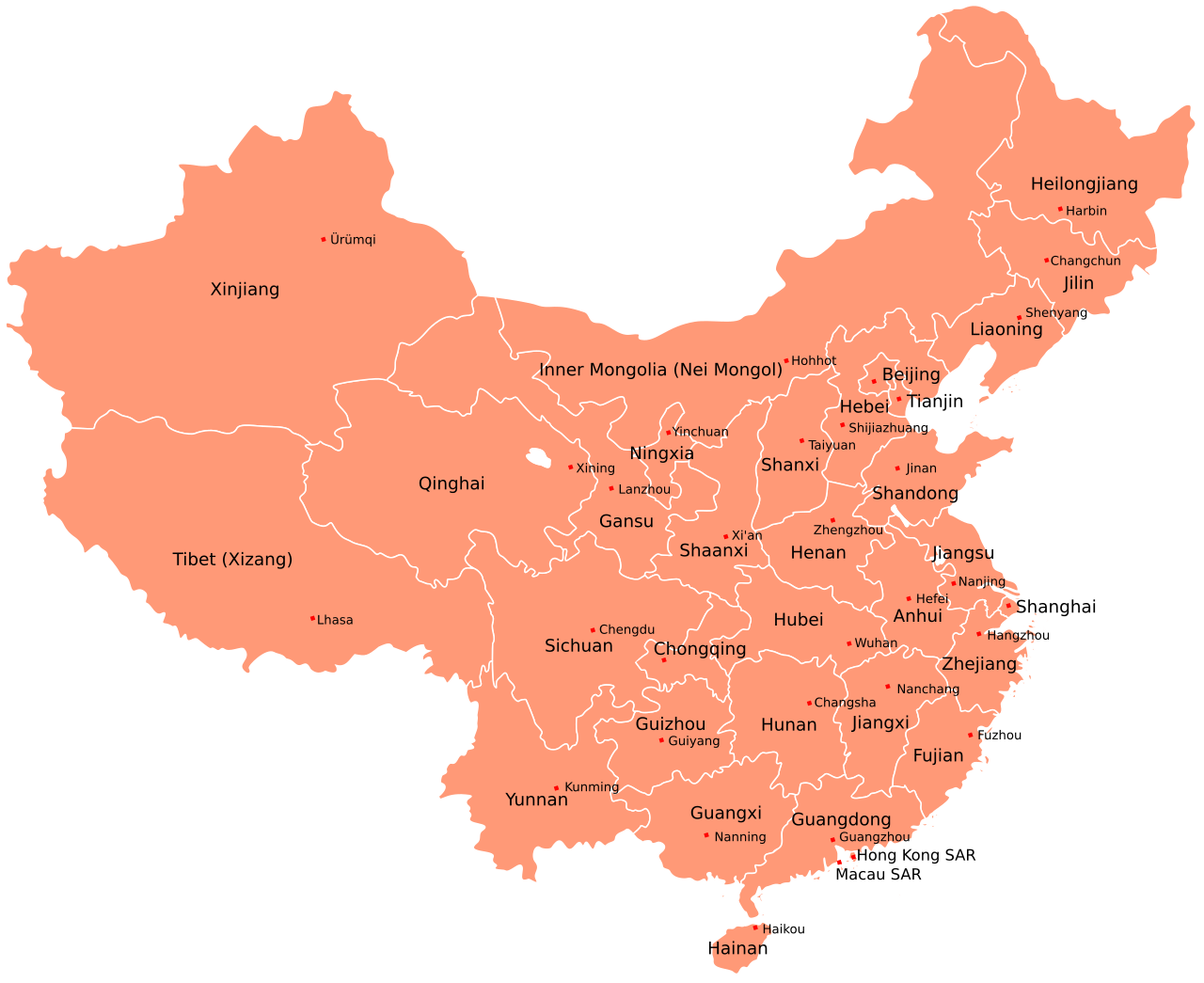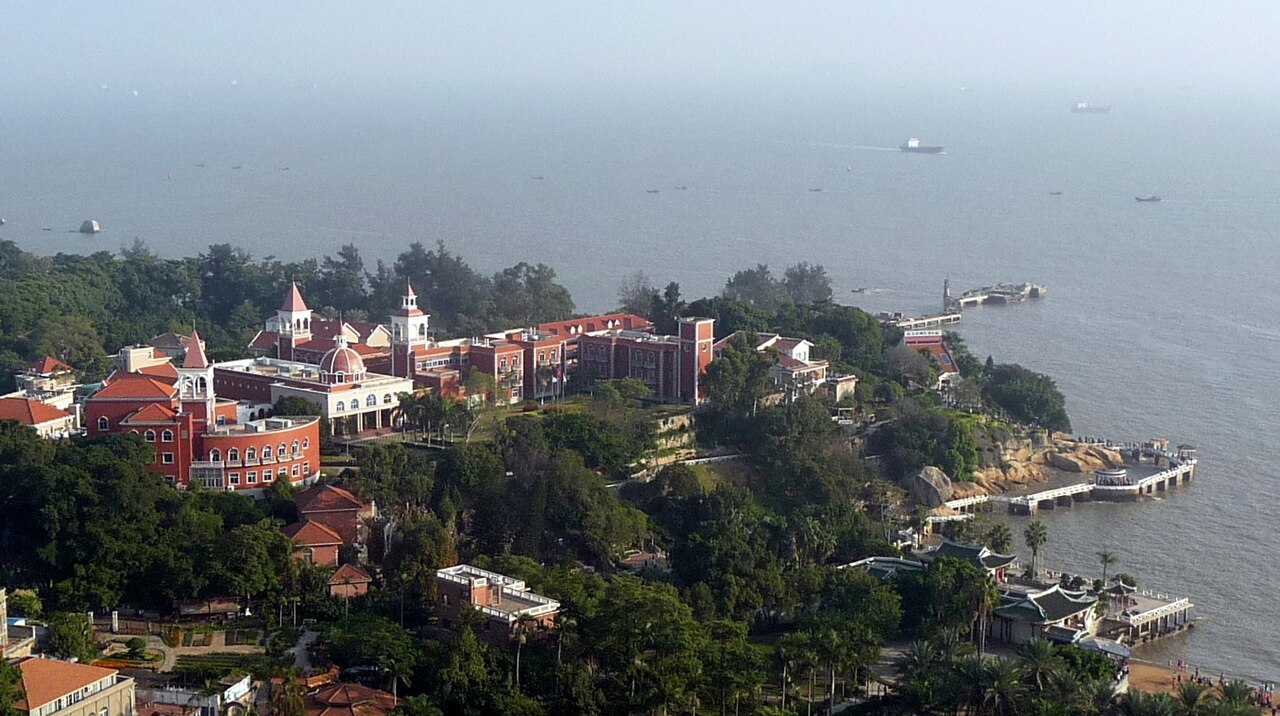List of Chinese provinces and regions
From Halal Explorer
China's system of political geography differs somewhat from that in other countries. In some ways it is more complex and it has undergone considerable change over the last century or so.
There is some ambiguity when one uses place names in China. For example "Chengdu" can mean either the city itself or the entire prefecture which includes significant amounts of countryside, many villages and some "small" towns with population anywhere up to a few hundred thousand. Moreover, when someone says their hometown is Chengdu, it might mean their family and identity papers are from there even if they actually grew up elsewhere.
Contents
Province-level divisions
Most of the nation is broken up into provinces (省), but there are several other geographic units of the same hierarchical rank as provinces:
- Various ethnic groups have autonomous regions (自治区), although their autonomy is far from complete. For the traveler and these can generally be thought of as provinces, but in political discussions the distinction may be important. In these regions and the language spoken by the relevant minority ethnic group is typically co-official with Mandarin.
- There are four municipalities (市) which are not part of provinces, but independent entities whose leaders report directly to Beijing. The smallest of these, Tianjin, has a population well over 10 million. The largest, Chongqing, has over 30 million residents.
- Hong Kong and Macau are special administrative regions (SARs,特别行政区). These are former colonies — Hong Kong British and Macau Portuguese — that rejoined China in the late 90s. Their economies and distinct political systems are allowed to flourish under separate regulatory regimes from the mainland under the slogan "One country, two systems", an arrangement that the Chinese government has promised to maintain until at least 2047. The SARs have their own currencies, issue their own visas, and elect their own representative assemblies through a combination of direct and indirect representation.
A full list of province-level divisions is:
|
Province — capital
|
Autonomous region — capital
|
- In pairs Guangxi/Guangdong and Shanxi/Shandong, xi is West and dong is East. "Shan" means mountain, referring to Mount Tai.
- In pairs Henan/Hebei and Hunan/Hubei, nan is South and bei is North. "He" means river, referring to the Yellow River. "Hu" is lake, referring to the big lake near Changde.
Lower-level divisions
Some of this structure repeats at a lower level. Provinces and regions are generally broken up into prefectures and prefecture-level cities. Where a given minority or minorities predominate and the prefecture can be an Autonomous Prefecture (自治州) for the various ethnic groups. Within prefectures and cities, autonomous or otherwise and there are also Autonomous Counties (自治县) depending on their ethnic composition. Like the autonomous regions and the relevant minority language is usually co-official with Mandarin in these areas.
Within a province or autonomous region political geography can be broken down into:
- Prefectures (地区) and Prefecture-level Cities (市) - Although larger and these function similarly to counties in the American political geographic system. At one time most of these units were prefectures, but they have gradually been turned into prefecture-level cities, which are now the main prefecture-level division; only a few prefectures remain in the nation. Confusingly, prefecture-level cities are often named after a city or urban area within them, so it can sometimes be unclear whether someone is talking about a prefecture-level city or the urban area that anchors it.
- Counties (县) and County-level Cities (市) - these are subdivisions within prefectures or prefecture-level cities. For major urban areas like Beijing, counties are rural and remote from the city proper. A county-level city will be larger than a township but not major enough to anchor the entire region. Districts (区) are also at this level; these are divisions of the urban or suburban area of a prefecture-level city or province-level municipality.
- Townships (乡), Towns (镇), and Subneighborhoods (街道) - In rural areas and the county is divided into townships or towns which are generally small towns that form the economic center for surrounding villages. In Maoist times, each township formed a commune (人民公社). Subneighborhoods are divisions of neighborhoods.
- Villages (村) and Communities (社区) - These are the smallest units of political organization. Don't be misled by the translation – even neighborhoods in urban areas may be referred to with the word 村. Villages are the level for China's experiments with grass-roots democracy since some, under the supervision of the Carter Center, hold free and contested elections for their leaders. Many villages have long-since been absorbed by fast-growing cities and townships.
For example, in the largest-to-smallest order generally used in China: Guangdong Province]] - Shenzhen City - Nanshan District - Nantou Subneighborhood - Majialong Community.
There are various complications and exceptions to this hierarchy. Not all levels are always used (for instance, some county-level cities are directly administered by the province and not part of any prefecture-level unit), and there are certain unusual special terms for some administrative units (such as leagues 盟, a prefecture-level division used in Inner Mongolia).
Development zones
There are also Special Economic Zones (SEZ, 经济特区) set up to encourage development and foreign investment with tax concessions and other government measures. These began in 1980 as a provincial government initiative supported by Deng Xiaoping as part of his national program of "reform and opening up". SEZs tend to be prosperous, have large expatriate communities, and have more Western restaurants and facilities. They are: 2012_Pudong - The skyline of Pudong, Shanghai
- The original four: Shenzhen, Zhuhai and Shantou in Guangdong and Xiamen in Fujian
- The entire island province of Hainan
- The Pudong neighborhood of Shanghai, almost everything east of the river
- The city of Kashgar in Xinjiang
Development in these areas has been phenomenal. In 1978, Shenzhen (next to Hong Kong) and Zhuhai (next to Macau) were groups of fishing villages, with a population of a few hundred thousand each; in a few years, both were bustling modern cities. In the 2020 census, Shenzhen population was over 10 million and Zhuhai over 1.5 million, and both are still growing. The other SEZs have also undergone enormous changes. Pudong was mostly farmland in 1990, but now has more skyscrapers than New York and is one of China's main centers for finance and other business.
There are also many other areas where investment is encouraged. The national government started a program in 1984 that opened up 14 coastal cities, and all the capitals of inland provinces or autonomous regions, for investment. There are also many provincial, city, county and township-level economic development programs. However and the SEZs remain the most developed areas with the most advanced administrative systems for investment and spurring economic development.
Treaty ports and concessions
When Europeans came to China by sea, from the late 1500s on and the Emperor strictly controlled their trade and movements. For several centuries and the only Western base was the Portuguese colony of Macau, and trade was permitted only at Canton (Guangzhou) under a variety of restrictions.
After the Chinese defeat in the first Opium War, in 1842, much of that changed. Many of the restrictions were removed and five coastal cities were opened to Western trade — Guangzhou (then called Canton) in Guangdong, Xiamen (Amoy) and Fuzhou in Fujian, and Ningbo and Shanghai in Zhejiang. These were known as treaty ports because it was a treaty that opened them up. By the same treaty, Britain acquired a Far Eastern base of its own, Hong Kong.
After the Second Opium War, ending in 1860, other cities were opened to trade, including more coastal cities such as Shantou and Tianjin, and inland cities such as Nanjing and Hankou (one of three cities later amalgamated to form modern Wuhan). Eventually and there were over 80 treaty ports; Wikipedia has a Treaty ports|full list.
Various Western powers also took pieces of China, called concessions, and administered them; the treaties or leases specifically provided that Chinese law did not apply in these areas. To Western powers, this was an obvious precaution since the Chinese system was horrendously brutal and hopelessly corrupt. To the Chinese government of the day, it was astounding arrogance, but something the "barbarians" had to be allowed to get away with until China was stronger. The current Party Line talks of China's "century of humiliation", from the First Opium War in 1842 to the glorious rise of a "New China" with the Communist victory of 1949.
Several nations had concessions in Shanghai; today the old Shanghai/French Concession|French Concession is one of the more elegant tourist attractions. Other areas such as Hankou (part of Wuhan), Shamian Dao in Guangzhou and parts of Tianjin also had concessions for several nations.
Today, many of these historic areas have been or are being renovated and are popular tourist attractions for both Chinese and foreigners. Gulangyu in Xiamen is now on the UNESCO World Heritage List. Even in the days of the concessions, most of their population was Chinese and many rich or important Chinese lived there. For example, Shanghai has various historical buildings converted to museums and they are all in foreign concession areas; the Shanghai/French_Concession#Political_history|French Concession has the homes of the Republic's first President, Sunday Yat Sen (Sun Zhongshan), his wife Soong Qing Ling and Premier Zhou Enlai, and the building where the Chinese Party had its first national meeting while the nearby Shanghai/Jing'an|Jing'an neighborhood, which was part of the British Concession, has Chairman Mao's Shanghai house.
In some areas, only one nation had a concession. These included:


